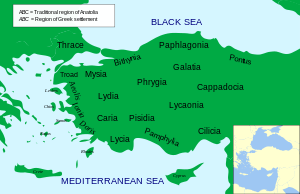Caria
| Caria (Καρία) | |
|---|---|
| Ancient Region of Anatolia | |

Theater in Caunos
|
|
| Location | Southwestern Anatolia |
| State existed | 11th–6th century BC |
| Language | Carian |
| Biggest city | Halicarnassus |
| Roman province | Asia |
 |
|
Caria (/ˈkɛəriə/; from Luwian: Karuwa, "steep country"; Ancient Greek: Καρία, Karia, Turkish: Karya) was a region of western Anatolia extending along the coast from mid-Ionia (Mycale) south to Lycia and east to Phrygia. The Ionian and Dorian Greeks colonized the west of it and joined the Carian population in forming Greek-dominated states there. The inhabitants of Caria, known as Carians, had arrived there before the Greeks. They were described by Herodotos as being of Minoan descent, while the Carians themselves maintained that they were Anatolian mainlanders intensely engaged in seafaring and were akin to the Mysians and the Lydians. The Carians did speak an Anatolian language, known as Carian, which does not necessarily reflect their geographic origin, as Anatolian once may have been widespread. Also closely associated with the Carians were the Leleges, which could be an earlier name for Carians or for a people who had preceded them in the region and continued to exist as part of their society in a reputedly second-class status.
Cramer's detailed catalog of Carian towns in classical Greece is based entirely on ancient sources. The multiple names of towns and geomorphic features, such as bays and headlands, reveal an ethnic layering consistent with the known colonization.
...
Wikipedia
